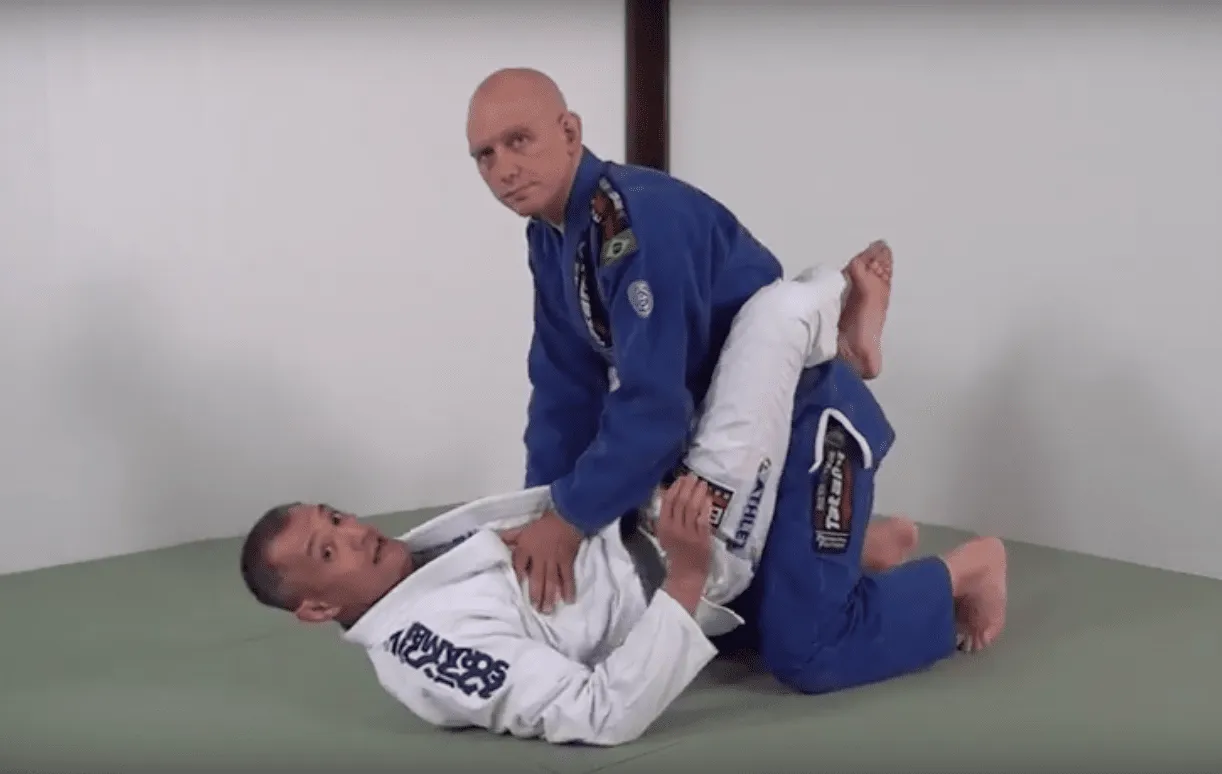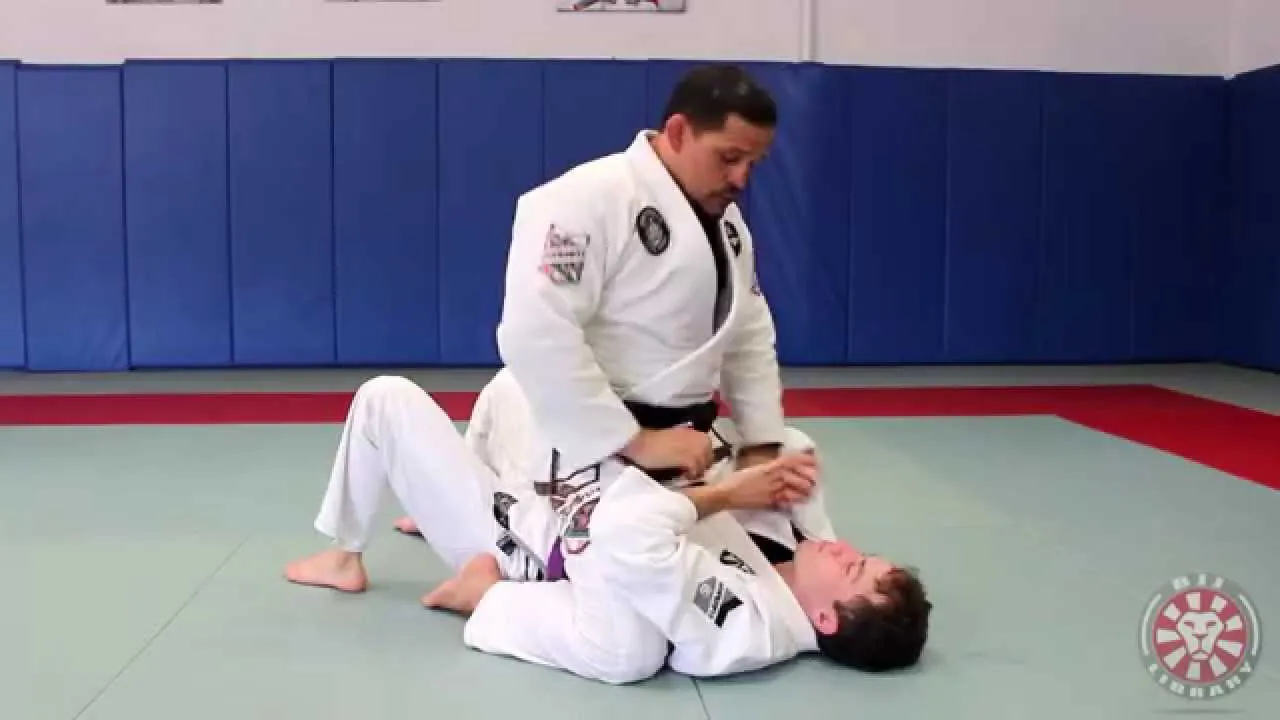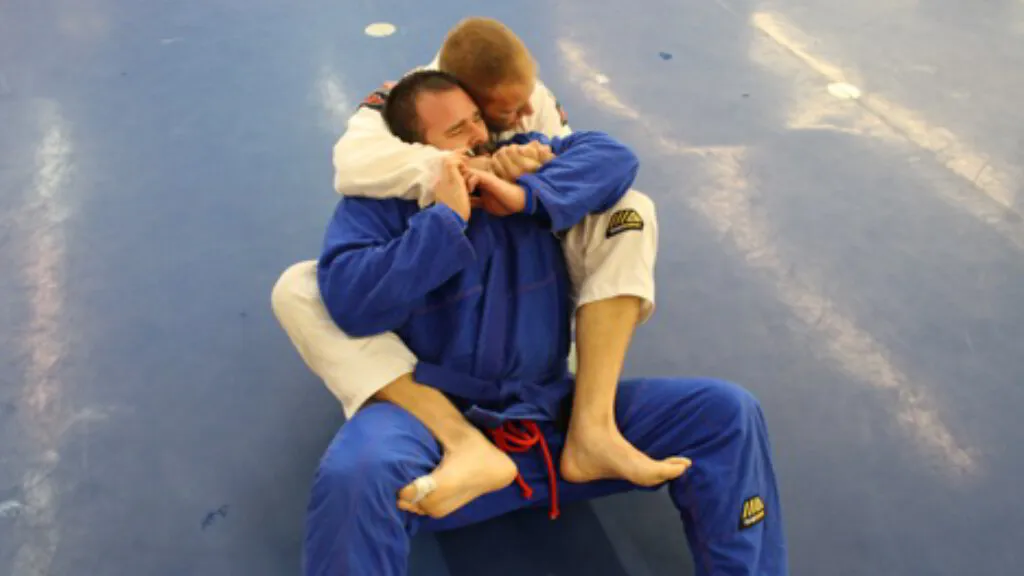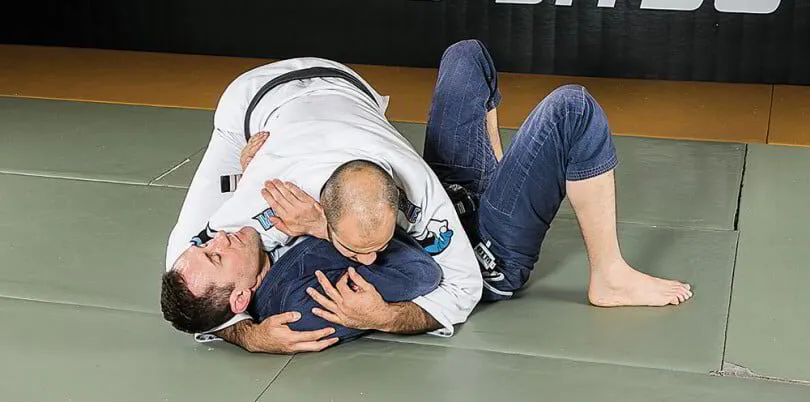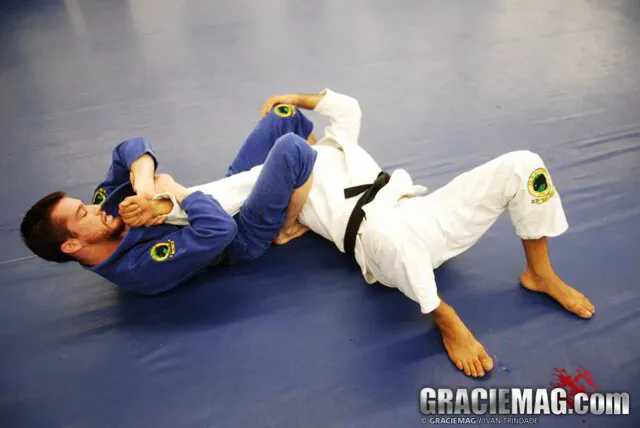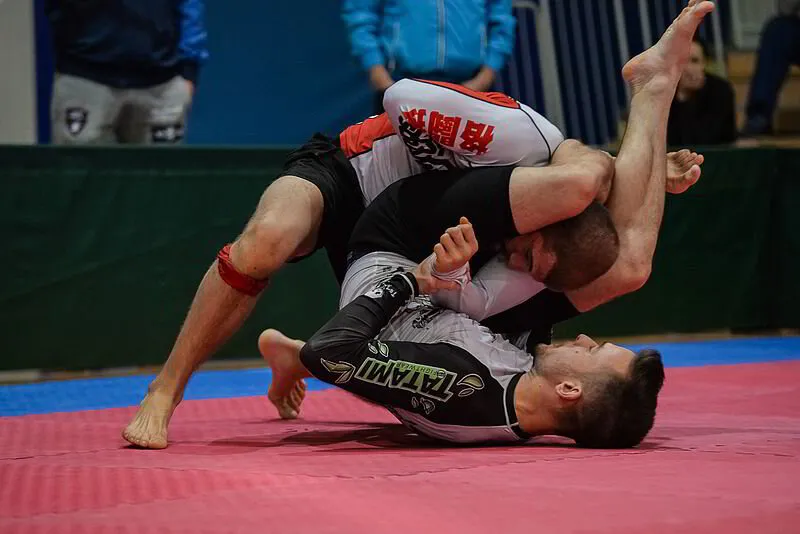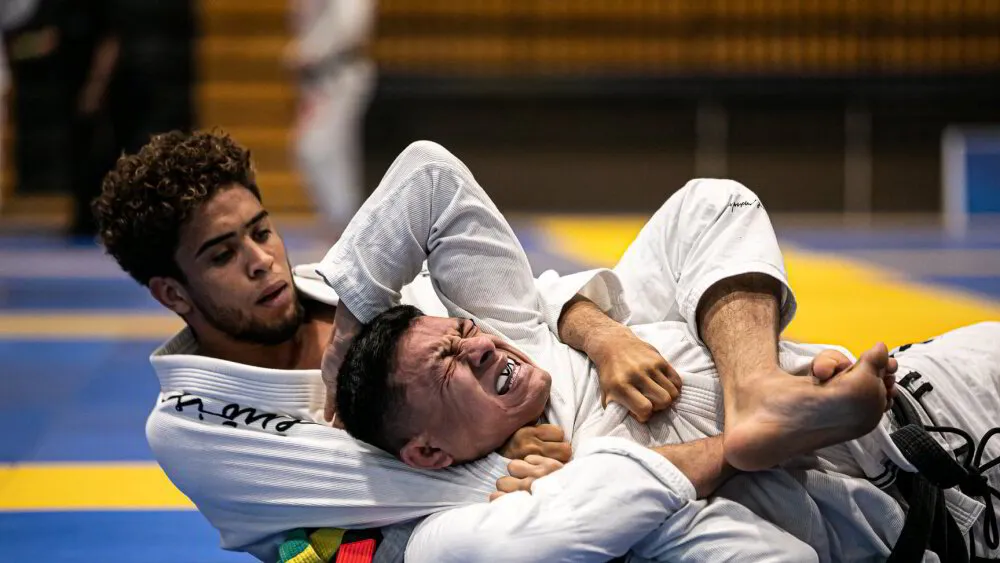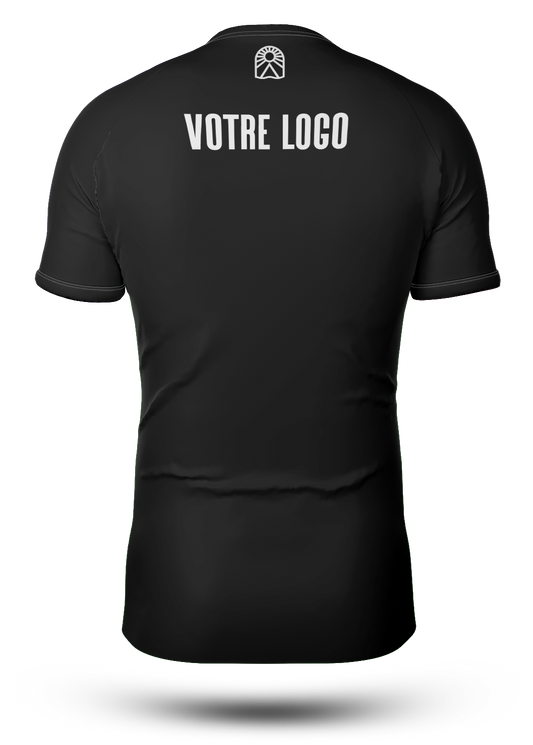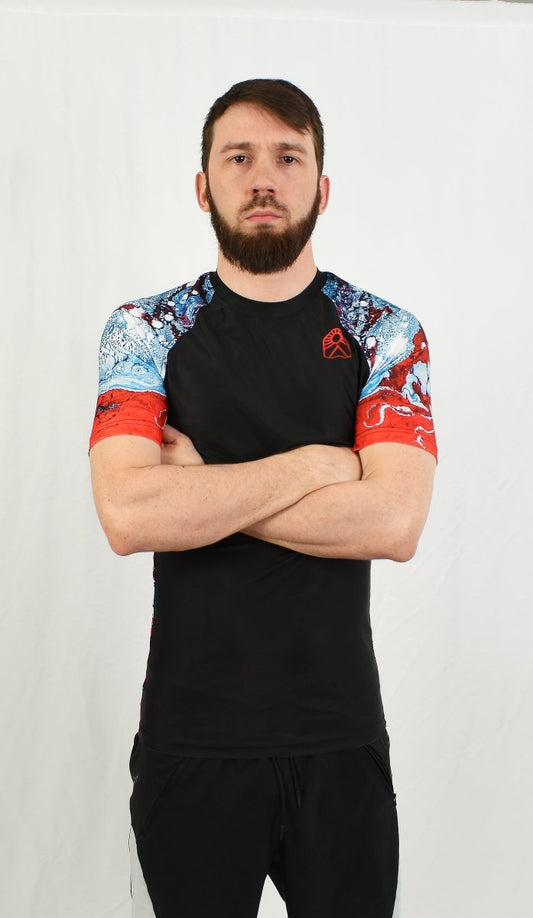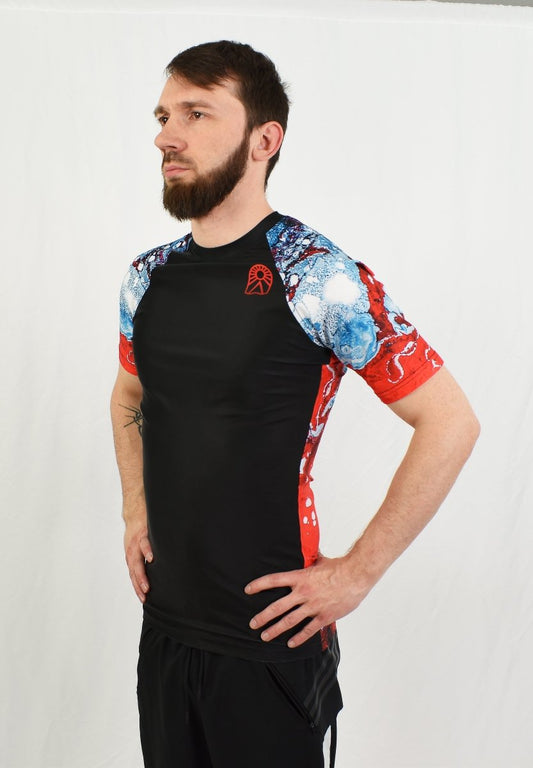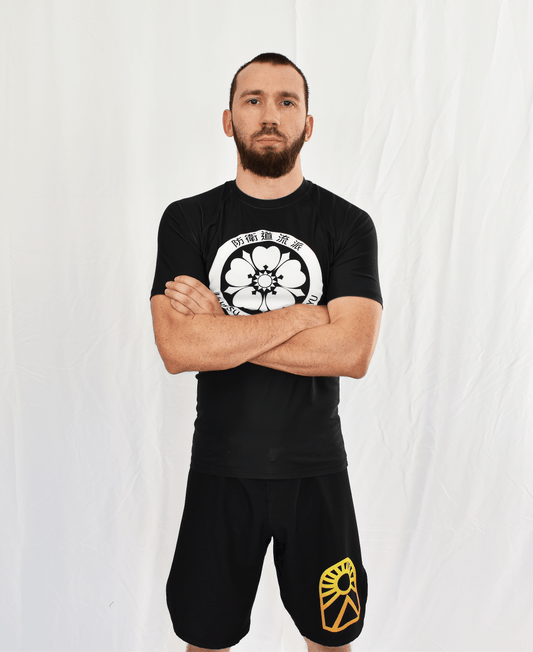
Brazilian Jiu-Jitsu: Everything you need to know when starting BJJ
Pascal CadoretteBrazilian Jiu-Jitsu : Here's Everything You Need to Know When Starting BJJ
You've watched the UFC, you've come across the fights of the greatest fighters like George St-Pierre, Charles Olieveira, Khabib Nurmagomedov or even Dustin Poirier and now you're interested in Brazilian Jiu-Jitsu !
You may know that it is much more than just a martial art.
It is a real tool to surpass yourself and master ground combat! A discipline that combines strategy and strength, and which has captivated thousands of enthusiasts around the world.
Whether you're a complete novice to the martial arts or have some experience, diving into the world of Brazilian jiu-jitsu is an adventure that goes far beyond strikes and submissions and (if you have the strength to persevere) will reward you beyond your expectations.
Brazilian jiu-jitsu (BJJ or BJJ), is a form of ground fighting that emphasizes technique and intelligence over brute force. It is a real chess game with the body. As you will have understood, here strength, size and weight have much less influence than direct technique.
Originating in Brazil, this discipline was developed to allow a smaller, weaker person to defend themselves effectively against a larger, stronger opponent. This philosophy has shaped BJJ into a form of martial art that favors subtlety of movement and sharpness of thought. Yes, because even on the ground, in the middle of a triangle choke, you will have to think!
Brazilian jiu-jitsu's popularity has quickly grown, attracting followers from all walks of life, especially thanks to the UFC ! But more particularly to the great fighters that can be seen fighting in the octagon or on UFC Fight Pass .
Whether it is to improve one's physical condition, develop one's self-confidence, or simply to take up a personal challenge, BJJ offers a deeply enriching experience.
However, like any new adventure, it is essential to start off on the right foot and know what you are getting into!
Taking your first steps into the world of Brazilian Jiu-Jitsu can seem intimidating, but with the right practices in hand, you can avoid common mistakes and progress more easily.
In this article, we will explore everything you need to know as a beginner in the world of Brazilian Jiu-Jitsu to get started and accelerate your learning!
From the fundamentals to practical tips, you will discover the initial steps of your journey in Brazilian Jiu-Jitsu.
Table of Contents
- Understanding the Basics of Brazilian Jiu-Jitsu
- Equipment and outfit needed in Brazilian Jiu-Jitsu
- Develop a workout routine
- Learning the fundamental positions in Brazilian Jiu-Jitsu
- Essential techniques and movements
- The spirit of Fair Play, Ethics and mutual aid in Brazilian Jiu-Jitsu
- Patience, resilience, perseverance and gradual progression
- Conclusion: Embracing the Brazilian Jiu-Jitsu Journey
Understanding the Basics of Brazilian Jiu-Jitsu
Origin and evolution
Brazilian Jiu-Jitsu has its roots in Japanese Jiu-Jitsu, but has evolved into a distinctive martial art with unique characteristics.
In the 1920s, the brothers Carlos And Helio Gracie from Brazil have adapted and transformed Japanese jiu-jitsu techniques to make them more effective in real combat situations.
In BJJ, the Gracie family is the pinnacle of Brazilian Jiu-Jitsu. If we're talking about the Gracies, we might as well listen up!
They emphasized the use of technique, subtlety and strategy to neutralize a larger, stronger opponent.
This gave birth to Brazilian jiu-jitsu as we know it today.
Fundamentals: Control, Submission, Positioning
At the heart of Brazilian Jiu-Jitsu are three fundamental principles that guide every exchange and every movement on the mat: control, submission and positioning.
Understanding these concepts is essential to progressing in the art of BJJ.
Control :
Control is the basis of all exchange in Brazilian Jiu-Jitsu.
It's about keeping your opponent pinned down while giving you the freedom to position your body strategically. Control can be established by using holds, pins, and joint locks to limit your opponent's movement and dictate the pace of the fight.
In short, you control the opponent's movements.
Submission :
Submissions are techniques that force your opponent to give up due to excessive pressure or imminent pain. When we talk about "tapping" we are talking about submitting. This is what we see in a UFC fight when a fighter, in an armlock, taps repeatedly to end the fight.
These moves include armlocks, chokes, and other restraint techniques. The ultimate goal of a submission is to end the fight without causing unnecessary injury.
Positioning:
Positioning is crucial to achieving effective control and successfully executing submissions. Knowing where to position your body in relation to your opponent's is essential to preventing escapes and maintaining the advantage. Positions such as guard, mount, back and side provide specific tactical advantages and help progress the fight towards a submission.
By understanding these fundamental principles and applying them in your training sessions, you will be able to develop a solid foundation in Brazilian Jiu-Jitsu.
However, remember that mastering these concepts takes time, practice and persistence. That's the beauty of Jiu-Jitsu. You won't learn it in one session, but these are concepts that you'll continually refine over time.
Each movement you learn will help strengthen your understanding of these principles, helping you become a competent and confident practitioner on the mat.
“BJJ is like a unique language. Two people doing Jiu-Jitsu together, it’s like having a debate. Like a language, there are infinite words to learn, but you also have to practice the correct pronunciation of each word. It’s a fabulous art.” ― Joe Rogan
Equipment and clothing needed in Brazilian Jiu- Jitsu
Fortunately, in Brazilian Jiu-Jitsu, there is not a ton of equipment. Especially since there are no punches or kicks, you will not need gloves or shin guards.
When you're getting started in the world of Brazilian Jiu-Jitsu, the equipment you choose plays a crucial role in your comfort, performance, and progression. (and the bruises you might get, yes!) .
There are two choices of outfits in Brazilian Jiu-Jitsu: the kimono (gi) traditional and non-kimono attire (no-gi) . Understanding the difference between these two options will allow you to make the right decision based on your preferences and goals. Each of the two offers different advantages and disadvantages.
Choice of outfit: kimono (Gi) or without kimono (No-Gi)
The kimono , also called "gi", is the traditional Brazilian jiu-jitsu outfit. Consisting of a long-sleeved jacket, pants, and a belt, the kimono offers a multitude of possible holds and grips thanks to the fabric. This adds an extra tactical dimension to your movements, as you must learn to use the gi to your advantage.
The no-gi outfit, or "no-gi" , is worn for training that focuses on ground fighting-specific movements and techniques without the use of cloth.
This means there are no sleeves or lapels to grab, making holds more difficult. The no-gi is also common for Brazilian jiu-jitsu competitions.
There is no one outfit that is better than another. In both cases, you will learn very effective ground fighting techniques. However, most schools offer different classes "with gi" or "no-gi", since there can be movements, techniques and specificities depending on the outfit.
In any case, wearing a compression t-shirt (rashguard) is highly recommended! This is a tight-fitting shirt that will greatly help you with flexibility, fluidity and the proper execution of your movements. Additionally, rash guards help tremendously in reducing the amount of bruising you'll get in your first few Jiu-Jitsu classes!
Types of Kimonos and Buying Tips
If you're going for a kimono (gi), there are a variety of styles and brands to choose from. It's recommended to choose a good quality kimono, as it will be subjected to constant stress during training (as well as a lot of strain, twisting, and roughness!).
Look for a sturdy cotton kimono, with reinforcements in strategic places to prevent premature wear. Hayabusa and Matsuru Canada are usually excellent choices!
As for Rashguards, you can find our many models available directly in our store !
When purchasing a kimono or rashguard, make sure you choose the right size. A rashguard that is too big can restrict your movements, while a rashguard that is too small can be uncomfortable and irritating. Check out our size guide to ensure you choose the correct size.
Hygiene and Compliance with Dress Codes
Hygiene is an essential aspect of Brazilian Jiu-Jitsu practice. Sincerely.
Remember one thing: you are doing ground fighting. There is a very strong proximity between each of the practitioners. It happens very often that we find ourselves with our noses in the armpit of the other, our faces pressed on the chest of the other, our faces stuck between two thighs. So, it is essential to have good hygiene.
Make sure to wear clean clothes to every workout to maintain a healthy environment for yourself and your training partners. Kimonos and no-gi gear should be washed regularly to prevent odors and skin infections. In fact, you may have trouble getting rid of bad odors from your rashguards, so check out our article How to Get Rid of Bad Odors from Your Rashguards for some great tips.
When it comes to dress codes, always follow the standards set by your school or club. Make sure your kimono is in good condition and conforms to your organization's specific rules. When wearing a kimono, make sure your belt is tied properly and respectfully, as the belt symbolizes your skill level and commitment to the martial art.
It may sound trivial, but watch your nails. Since wrestling involves a lot of gripping, it's easy to get cut and scraped with long nails. Trim your nails, wash yourself and your clothes, and your workouts will be much more enjoyable for everyone.
Develop a workout routine
When it comes to getting involved in Brazilian Jiu-Jitsu, the key to success is having a solid training routine in place. Brazilian Jiu-Jitsu is tough. If you want to progress, you will need to be disciplined, rigorous and persistent.
Brazilian Jiu-Jitsu is not just a sport, it is an art that requires time, practice and a progressive approach. Below are some tips to help you establish a realistic and beneficial training routine for your progression:
Establish a realistic and progressive schedule
The first step to developing an effective workout routine is to determine a schedule that fits into your daily life.
It may seem trite and obvious, but repetition is the key to learning BJJ. Set a time in your schedule and stick to it.
It's best to start small with two to three workouts per week and not go too hard. Most of the learning in BJJ is done through trial and error that you learn on the tatami (the training mat). You will have to ride many times to familiarize yourself with the techniques and learn (and you will have to get strangled several times in order to learn!).
Over time, you can increase the frequency as you adjust to the workload.
Additionally, variety is important. Alternate between gi and no-gi sessions to develop balanced skills in both environments. Also, try to take specific classes, such as those focused on positioning, submissions, or transitions, to diversify your learning.
The key to progression is not to count the victories and submissions that you manage to do... But to focus on the small, gradual victories that you manage to get. Like escaping from a full guard, protecting yourself from an armlock, surviving your rounds, etc.
Regularity, patience and perseverance in progress
Consistency is the key to progression in Brazilian Jiu-Jitsu. It is better to do a few training sessions per week consistently than to do intensive sessions sporadically. Repetition is the key to integrating movements and techniques into your muscle memory.
In BJJ, we really talk about repetition and learning by trial and error.
Patience is also a crucial virtue. Brazilian jiu-jitsu is a long-term journey, and it is natural to feel frustrated or discouraged when faced with initial challenges. The average time to reach the blue belt is between 18 months to 3 years. You will find a complete guide that explains all the belts in jiu-jitsu , their meanings and the prerequisites to access them.
Remember that everyone progresses at their own pace. Celebrate small victories and improvements, no matter how insignificant they may seem. The accumulation of these positive moments will eventually form a steady progression curve.
An often overlooked aspect of progression is recovery time. Listen to your body and give yourself plenty of time to recover between workouts. Sleep, nutrition, and stretching play a vital role in your ability to perform and recover effectively.
In short, developing an effective training routine requires realistic planning and ongoing commitment. By sticking to a progressive schedule, remaining consistent in your efforts, and cultivating patience, you will open the door to steady progression in the captivating world of Brazilian Jiu-Jitsu.
Learning the fundamental positions in Brazilian Jiu-Jitsu
When you enter the world of Brazilian Jiu-Jitsu, one of the first things you will learn is the importance of stances. Stances form the foundation of your game and dictate your movement, control, and submission opportunities. Understanding and mastering the fundamental stances is essential to building a solid foundation in this complex martial art.
Basic Positions: Guard, Mount, Back, Side
The Guard:
Guard is a defensive position where you are underneath your opponent, usually lying on your back. It involves using your legs and arms to prevent your opponent from passing and controlling you. The guard can be open (Open Guard) (legs apart) or closed (Closed Guard) (legs wrapped around the opponent). The guard is a key position for defense and offense, providing many opportunities to turn the tables.
If your opponent gets the upper hand on you, the Guard is a good way to protect yourself from this dominant position and transition to a sweep to regain the upper hand.
Image source ( InFighting.ca )
The Climb (Mount):
The mounted position is a dominant position where you sit on your opponent's torso with your knees on either side of their hips. This is an ideal position for controlling your opponent and performing submissions because you have the upper hand over your opponent. The mount is often considered an extremely powerful controlling position.
Image Source ( BJJMore )
The Back:
The back position is one of the most advantageous positions in Brazilian Jiu-Jitsu. It occurs when you are behind your opponent, controlling his back. This position allows for powerful submissions, such as the rear-naked choke, while severely limiting your opponent's defense options.
You have a great position because you have good vision of your opponent, while he has poorer vision (and less control) of you.
Image source ( BJJMoves )
The Side:
The lateral position (or side position) is a position where you lie on your opponent's side, controlling their torso and hips. This position allows for good control and provides opportunities for submissions and transitions to more advantageous positions.
Image source ( BJJ-World )
The importance of mastering these positions
Mastering the fundamental positions is essential, as they form the basis of your game and understanding of Brazilian Jiu-Jitsu. In a match, you will have to transition from one position to another and face your opponent who also wants to transition from one position to another.
Each of these positions offers unique opportunities for control, defense, and offense. By understanding how to position yourself strategically, you can exploit your opponent's weaknesses while minimizing risk to yourself.
Additionally, fundamental positions teach you the importance of control and patience. Brazilian jiu-jitsu is a physical chess game where every move has a counterpart. Learning to control your opponent and predict their reactions will help you develop a more holistic view of the fight.
As early as possible in your progression, you will need to learn to think several moves ahead to anticipate what your opponent will do during your transitions and movements.
By investing time in learning and mastering these positions, you will build a solid foundation for your Brazilian Jiu-Jitsu journey. Remember that regular practice, patience and persistence are necessary to transform these positions into powerful tools in your arsenal of techniques.
Essential techniques and movements
One of the most exciting aspects of Brazilian Jiu-Jitsu is learning the techniques and movements that make up this vast arsenal.
These techniques, when mastered, will allow you to navigate the mat with confidence and assurance.
Among the many options, some fundamental techniques stand out due to their effectiveness and applicability in different situations. We will explore a few of these essential techniques: the armlock, the armbar, and the rear choke.
Fundamental Techniques: Armlock, Triangle Choke, Rear Choke
The Armlock:
The armlock is one of the most fundamental and iconic submissions in Brazilian jiu-jitsu. It involves controlling your opponent's arm and bending it in an unnatural direction, putting pressure on the elbow joint. This technique can be applied from a variety of positions, including the guard and the mount.
Image source ( Graciemag.com )
The Triangle Choke:
The triangle choke is a versatile submission technique that involves trapping your opponent's head and arm between your legs, forming a triangle.
By contracting your thighs, you put pressure on the arteries in your neck, forcing your opponent to give up. This technique can be performed from a variety of positions, including guard.
Image source ( YouJiuJitsu )
Rear Choke:
The rear-naked choke is an effective submission technique that is often performed from the back position. It involves sliding your arm under your opponent's neck to apply pressure to the arteries in the neck, causing unconsciousness if the opponent does not submit.
Image source ( Evolve-MMA )
Need to understand mechanics
Although these techniques may seem simple at first glance, it is essential to understand the mechanics behind each move.
Each technique is based on precise anatomical and physical principles. Understanding how to position your hands, arms, legs and body in each step of the technique is crucial to ensuring effective and safe execution.
The mechanics of technique go beyond simply mimicking movements. It involves a deep understanding of how pressure, angle, and body control interact to create maximum effect. By developing this understanding, you will be able to adjust your movements based on your opponent's reactions and capitalize on opportunities that present themselves.
Take the time to practice these techniques repeatedly and thoroughly. Explore the subtleties of each movement and be prepared to ask your instructors questions to clarify more complex aspects.
The spirit of Fair Play, Ethics and mutual aid in Brazilian Jiu-Jitsu
Brazilian Jiu-Jitsu is more than just a sport or a martial art. It is a community built on deep values of respect, integrity, and camaraderie. Beyond techniques and competitions, respect for your training partners and a willingness to maintain high ethical standards are essential elements that define the very essence of Brazilian Jiu-Jitsu.
Culture of respect and camaraderie
Respect is at the heart of Brazilian Jiu-Jitsu culture. When you step onto the mat, whether for training or competition, it is crucial to treat each partner with respect and consideration. Each individual has their own story and skill level.
Camaraderie is also a key aspect of this culture. Your training partners are not your opponents, but rather allies in your learning journey. You can learn as much from your failures as you can from your successes, and your partners are there to help you grow as a Brazilian jiu-jitsu practitioner.
When you step onto the mat, you also put your ego aside. It's not about being the strongest. It's about being humble, respectful and helping each other. Adapt to your training partners.
Act with ethics and respect
Acting ethically means respecting the rules and principles of Brazilian Jiu-Jitsu, whether on or off the mat. During training, always be aware of your partners' limits and avoid sudden or uncontrolled movements that could cause injuries.
Respect submissive signals and release immediately when your partner taps or says a submissive word.
Outside of training, treat your fellow practitioners with the same respect and dignity that you expect. Avoid unfair behavior, cheating, or any form of unhealthy competition. Brazilian Jiu-Jitsu teaches you to be humble in victory and accept defeat with grace.
Always remember that your behavior on the mat is a reflection of your ethics and character off it. Brazilian Jiu-Jitsu is a journey that goes far beyond physical movements. It is an opportunity to develop not only your technical skills, but also your human qualities.
By integrating the spirit of fair play, respect and ethics into your Brazilian Jiu-Jitsu practice, you help to nurture a supportive and ethical community. Your positive and respectful behavior not only enhances your own experience, but it also inspires others to follow suit.
Patience, resilience, perseverance and gradual progression
When you're new to the world of Brazilian Jiu-Jitsu, it's important to remember that progress doesn't happen overnight.
Brazilian Jiu-Jitsu is a demanding journey that requires time, patience, and consistent commitment. Learning this martial art and developing solid skills takes dedication, and it’s important to keep a few key principles in mind to stay motivated throughout your journey.
Reminder of the gradual progression
Progression in Brazilian Jiu-Jitsu is similar to the growth of a plant. It does not happen in an instant, but rather over time, accumulating experience and knowledge.
The top belts you see on the mat all started as beginners, and they went through the same challenges and stages as you. Every training session, every little technical adjustment, and every failure contributes to your progress.
Celebrating small victories
It's easy to focus on long-term goals and feel discouraged by the road ahead.
However, it’s just as important to celebrate the small victories along the way. Every time you master a new technique, perform a clean submission, or have a successful exchange with a training partner, consider it a victory.
These moments of improvement help build your confidence and keep you motivated.
Stay motivated
Motivation may fluctuate throughout your journey, but there are ways to keep it consistent.
Set realistic short-term goals to help you track your progress. If you focus solely on the belt you’ll wear in the future, you may feel discouraged. Instead, set goals like mastering a specific skill, competing in your first competition, or simply attending practice regularly.
Also, don’t underestimate the power of community. Share your experiences with your classmates, ask your instructors for advice, and enjoy moments of mutual support.
By the way, in Solar's newsletter, we celebrate the victories of every martial arts fighter who writes to us. If you want to share your victories, then join our weekly emails here .
Your support network can help you overcome moments of doubt and stay motivated no matter what challenges arise.
Ultimately, remember that every step of your Brazilian Jiu-Jitsu journey is an opportunity for learning and growth. Patience, celebrating small victories, and persistence are the keys to achieving your goals and discovering the profound benefits Brazilian Jiu-Jitsu can offer.
Conclusion : Embrace the Brazilian Jiu-Jitsu Journey
Congratulations on embarking on this exciting journey into the world of Brazilian Jiu-Jitsu. You now have a solid understanding of the essential foundations for successfully entering this captivating martial art. From choosing your outfit to learning the fundamental positions and key techniques, you have acquired the knowledge necessary to begin exploring the many dimensions of Brazilian Jiu-Jitsu.
Always remember that Brazilian Jiu-Jitsu is more than just a series of moves. It is an experience that will transform you physically, mentally, and emotionally. You will develop unwavering discipline, a deep understanding of body mechanics, and a connection with a community of like-minded enthusiasts.
As you walk this path, keep in mind the principles of respect, camaraderie, ethics, and patience. These values form the foundation of your practice and help shape your identity as a Brazilian Jiu-Jitsu practitioner. By keeping these values in mind, you will not only flourish as a fighter, but as a person.
Remember that this journey is yours, unique and personal. Celebrate every victory, no matter how big or small, and stay open to the lessons that each challenge will bring. Your progress will be constant, and each step will bring you closer to mastering this dynamic martial art.
Whether you choose to focus on improving your technical skills, competing in competitions, or simply enjoying the physical and mental benefits of Brazilian Jiu-Jitsu, this trip will provide you with invaluable experiences.
The mat is your canvas, and every move is a brush of progression. So, keep training, learning, and growing, and you will reap the rewards of your efforts on the exciting path of Brazilian Jiu-Jitsu.


